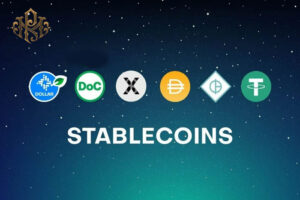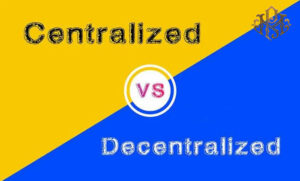
Close



Stablecoins have emerged as a vital component of the digital currency ecosystem, offering stability, reliability and efficiency in the transfer of value. They are designed to reduce the inherent volatility of traditional digital currencies such as Bitcoin, which tie their value to fiat currencies or other assets. However, stablecoins can be classified into two main types based on their underlying structure: centralized and decentralized. In this article, we explore the concepts of centralized and decentralized stablecoins, explore their key features, advantages and disadvantages, and discuss their implications for the broader cryptocurrency landscape.
Before delving into centralized and decentralized stablecoins, let’s first establish a basic understanding of stablecoins.
Stablecoins are digital assets designed to maintain a constant value relative to a specific reference asset, such as fiat currencies (such as the dollar, euro), commodities (such as gold), or other digital currencies. They provide a bridge between the traditional financial system and the crypto market, providing users with the benefits of blockchain technology while minimizing price volatility.

Stability: Stablecoins aim to maintain a stable value relative to their underlying reference asset, usually through mechanisms such as stabilization, collateralization, or algorithmic stabilization.
Transparency: Stablecoins often operate on public blockchain networks, enabling transparent issuance, redemption, and auditing processes.
Accessibility: Stablecoins facilitate seamless and low-cost cross-border transactions, offering users a viable alternative to traditional fiat currencies for remittances and payments.
Programmability: Many stablecoins are programmable tokens built on smart contract platforms such as Ethereum, allowing for the automation of financial transactions and the creation of decentralized applications (DApps).
Centralized stablecoins are issued and managed by a central entity, usually a company or financial institution. They rely on trusted third parties to maintain stability, manage inventories and ensure compliance with regulatory requirements.
Issuer Control: Centralized stablecoins are managed by an issuer or a consortium of entities, giving them full control over the issuance, redemption, and management of the stablecoin supply.
Custodial Reserves: Centralized stablecoins are often backed by reserves held in bank accounts or other traditional financial instruments. The issuer holds these reserves, which act as collateral to support the stablecoin’s link to the reference asset.
Regulatory Compliance: Centralized stablecoins are subject to regulatory oversight and compliance requirements, including Anti-Money Laundering (AML) and Know Your Customer (KYC) regulations. Exporters must comply with legal and regulatory standards to operate within the framework of the law.
Trusted Intermediaries: Users of centralized stablecoins must trust the issuer and other intermediaries involved in the stablecoin ecosystem. While centralized stablecoins offer stability and reliability, they introduce counterparty risk related to the solvency and operational integrity of the issuer.
Tether (USDT): Tether is one of the oldest and most widely used stablecoins linked to the value of the US dollar. It was published by Tether Limited, a company that claims to maintain a 1:1 USD to USDT reserve ratio in bank accounts.
USD Coin (USDC): USD Coin is a stablecoin pegged to the US dollar and issued by regulated financial institutions, including Coinbase and Circle. The company operates within the framework of the CENTER Consortium, which sets standards for the issuance and governance of stablecoins.

Decentralized stablecoins, also known as algorithmic stablecoins, operate without an issuer or central authority. Instead, they use decentralized mechanisms such as smart contracts and algorithmic algorithms to maintain stability and manage the stablecoin supply.
Key features of decentralized stablecoins
Algorithmic stability: Decentralized stablecoins use algorithmic mechanisms to adjust the supply of stablecoins in response to changes in demand and market conditions. These algorithms may incorporate mechanisms such as premium shares, collateral or algorithmic rebalancing to stabilize the value of the stablecoin.
Decentralized governance: Decentralized stablecoins operate on blockchain networks governed by decentralized communities of users. Decisions regarding protocol upgrades, parameter adjustments, and governance proposals are made through on-chain voting mechanisms, giving users a voice in the evolution of the stablecoin.
Collateral and additional collateral: Some decentralized stablecoins are collateralized by digital currency assets locked in smart contracts as collateral. Over-collateralization ensures that the value of the collateral exceeds the stablecoin supply, creating a buffer against price fluctuations and ensuring stability.
Transparency and Auditability: Decentralized stablecoins offer transparency and auditability through open source code and on-chain transactions. Users can verify the integrity of the stablecoin’s algorithmic mechanisms and collateral ratios, reducing reliance on trust.
DAI : DAI is a decentralized stablecoin issued by MakerDAO, an independent decentralized organization on the Ethereum blockchain. DAI is collateralized by a diverse range of crypto assets locked in smart contracts known as Collateralized Debt Positions (CDP).
Terra (LUNA): Terra is a decentralized stablecoin ecosystem that operates on multiple blockchain networks, including Terra’s native blockchain and Ethereum. It uses algorithmic stabilization mechanisms and a decentralized validation network to maintain stability.
The distinction between centralized and decentralized stablecoins has important implications for users, investors, and the broader cryptocurrency ecosystem.
Risk and trust: Centralized stablecoins offer stability and regulatory compliance, but introduce counterparty risk related to the solvency and operational integrity of the issuer. Decentralized stablecoins aim to minimize reliance on trusted intermediaries, but may face challenges related to algorithmic stability and collateralization.
Regulatory Scrutiny: Centralized stablecoins are subject to regulatory oversight and compliance requirements that may affect their adoption and operational flexibility. Decentralized stablecoins, while offering greater decentralization, may face regulatory uncertainty associated with algorithmic stability mechanisms and collateral practices.
Innovation and experimentation: The emergence of decentralized stablecoins has led to innovation in algorithmic finance, decentralized governance, and decentralized finance (DeFi). However, experimental protocols and algorithmic mechanisms may pose risks to users and require constant iteration and refinement.
Centralized and decentralized stablecoins represent two distinct approaches to achieving stability and reliability in the cryptocurrency ecosystem. While centralized stablecoins offer regulatory compliance and issuer accountability, they introduce counterparty risk and reliance on trusted intermediaries.